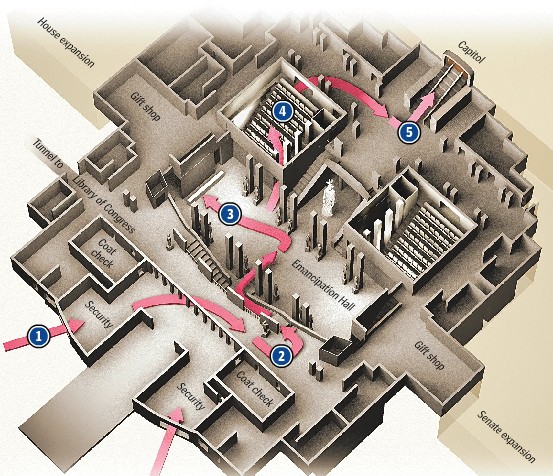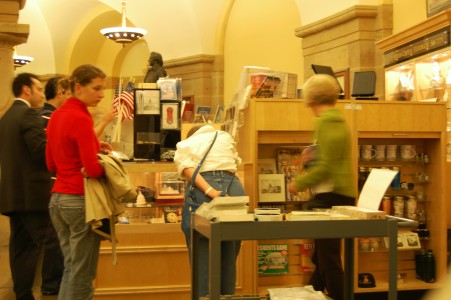

The United States Capitol is located in Washington, D.C., on top of Capitol Hill at the eastern end of the National Mall. The capitol serves as the seat of government for the United States Congress which is the legislative branch of the U.S. federal government.
The Neoclassical architecture of the capitol building features the Statue of Freedom on top of its dome. The US Capitol is a popular tourist destination, but there are a few things that you must know before you take a tour.

Parking
It is difficult to park close to the capitol. If you are lucky enough, you may be able to park free
along Madison and Jefferson Drives in front of the Smithsonian museums by the National Mall
where there are no parking meters. Otherwise, you may need to park at a meter and feed it
every two hours. There are also parking garages in the area, but they are relatively more
expensive and further away. The nearest public parking facility is in Union Station, to the North of the Capitol.
Another option, is to take the
Washington D.C. Metro to the Capitol South Metro station which is one block from the Capitol building.
There are many parking spaces close to the capitol reserved for cars with special stickers.
Unauthorized cars are quickly ticketed and towed away.
Security
New security measures were implemented after the terrorist attacks
of 9/11/2001, and all visitors must go through a screening process similar to the ones at airports.
Bottles of water, food, and sharp objects like scissors are forbidden. Cameras and purses are X-rayed,
and every person must pass through metal detectors. You will be asked to
discard any forbidden items to proceed with the tour.
Tour Ticket
Tour tickets for the U.S. Capitol are obtained at the Capitol Guide Service Kiosk that has been set up
on the south side of the capitol. Tickets are only given to the persons at the kiosk. You are not
allowed to get a ticket for a person who is not physically present at the kiosk.
Tickets are distributed beginning at 9:00 AM on a first-come, first-served basis
and organized into guided tours that depart from the tent by the kiosk approximately every 15 minutes.
Since there are many visitors, you may have to wait some time before your group is asked to gather under the tent by the kiosk. While you wait, you can walk across the street and examine the exotic vegetation at the Botanic Garden greenhouse, but be sure to get back before your scheduled capitol tour time.
South Visitor Receiving Facility
All visitors are asked to detach the sticky iridescent label from their ticket and place it on their clothing.
The tour starts by going through a security building with a green canopy. After the security screening,
the group exits by a boardwalk to the Capitol building.
In 2008, the temporary kiosk and the security building on the South side of the Capitol will be replaced by an underground visitor center located on the East side of the Capitol, across from the Library of Congress. This is the floor plan for the visitor center:

From the Capitol, looking toward the West, you can see the National Museum of the American Indian, the Washington Monument, and the domes of several museums that line the National Mall. The Lincoln Memorial is at the far end of the Mall, behind the Washington Monument.
When a group gathers at the west entrance of the capitol on the second floor, each person is offered earphones. There are so many people in the rotunda and so many tours, that it is very difficult to hear the guide without earphones.
Congressional staffers, such as Michael Berndt, work as U.S. Capitol guides. The guides identify the important features of the capitol and provide historical and anecdotal information about the architecture, the paintings, and the men and women represented by the statues that adorn the room.
The Rotunda is a ceremonial center where state funerals have been held for presidents, distinguished members of Congress, and eminent citizens. The top of the US Capitol dome features a fresco by Constantino Brumidi, The Apotheosis of Washington. The fresco was painted in 1865 and depicts George Washington surrounded by symbols of American democracy and technological progress. In the central group of the fresco, Brumidi depicted George Washington rising to the heavens in glory, flanked on his right by a female figure representing Liberty wearing a red cap of emancipation and, on his left, a female figure representing Victory sounding a trumpet. The detail below also shows Mercury, the messenger of the gods, handing a bag of money to Robert Morris, financier of the American Revolution, and to the right, Neptune holds his trident and Venus holds the transatlantic cable which was being laid at the time the fresco was painted.
The hallways and corridors in the capitol have beautiful marble floors, and luxurious chandeliers.
The National Statuary Hall, also known as the Old Hall of the House, is a semicircular room south of the Rotunda. This hall is the main exhibition space for the National Statuary Hall collection and has statues representing every state of the Union. The hall was the meeting place of the U.S. House of Representatives for nearly 50 years until the House moved into its present chamber in the new House wing in 1857.
The first floor of the Capitol has a large circular area called the Crypt with forty neoclassical doric columns. The original purpose of the crypt was to provide a final resting place for the body of George Washington. The crypt was completed in 1827. The plans to inter Washington in the Capitol failed due to the legal requirements of Washington's will and the refusal of the plantation's owner at the time, John Washington, to release the remains.
There is a little gift shop in the crypt that sells souvenirs such as charms, pins, and other Capitol-themed products.

The tour of the U.S. Capitol ends at the crypt. Tourists are then free to walk around the crypt and exit on the East side of the Capitol building which faces the Library of Congress.